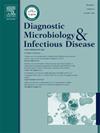IR生物分型仪作为一种对医院流行病学有意义的生物分型工具的研究综述。
IF 2.1
4区 医学
Q3 INFECTIOUS DISEASES
Diagnostic microbiology and infectious disease
Pub Date : 2024-12-30
DOI:10.1016/j.diagmicrobio.2024.116676
引用次数: 0
摘要
红外生物打字器是一种基于傅里叶变换红外(FTIR)光谱系统的新型实时打字工具。它已成为各种微生物的菌株分型和检测其在医院内克隆传播的一种有前途的方法。本文就IR生物分型仪在医院流行病学中的应用及准确性作一综述。我们的综述纳入了29项研究,这些研究评估了IR Biotyper在医院内用于微生物菌株分型和疫情调查的使用。20项研究评估革兰氏阴性菌,7项研究评估革兰氏阳性球菌,3项研究评估念珠菌,1项研究评估脓肿分枝杆菌复合体(MABSC)。在本综述纳入的研究中,共有3140株菌株被分型。IR Biotyper对所有被评估生物分型的总体平均准确率为84% (SD: 22, 95% CI: 83-85)。葡萄糖非发酵革兰氏阴性杆菌的准确度较高(93%,SD: 12, 95% CI: 93-94),其次是革兰氏阳性球菌(84%,SD: 10, 95% CI: 83-84),肠杆菌(78%,SD: 20, 95% CI: 76-80)和念珠菌(56%,SD: 26, 95% CI: 52-60)。摘要:IR生物分型仪可能是一种很有前途的菌株分型工具,在医院环境中具有实用价值。该工具在有效的周转时间内提供微生物菌株识别,与本综述中评估的大多数生物体的基于基因组的方法具有相当的准确性。需要进一步的研究来证实这些发现,并评估其对医院流行病学有重要意义的其他生物体的用途。本文章由计算机程序翻译,如有差异,请以英文原文为准。
The IR Biotyper as a tool for typing organisms of significance for hospital epidemiology- A subject review
The IR Biotyper is a novel real-time typing tool, based on a Fourier-transform infrared (FTIR) spectroscopy system. It has emerged as a promising method for the strain typing of various microorganisms and for the detection of their clonal spread within hospitals. In this review, we aim to present the applications and accuracy of the IR Biotyper in hospital epidemiology. Twenty-nine studies that evaluated the use of IR Biotyper for organism strain typeability and outbreak investigations within hospitals, were included in our review. Twenty studies assessed gram negative bacteria, seven studies assessed gram positive cocci, three studies assessed Candida spp., and one study assessed Mycobacterium abscessus complex (MABSC). A total of 3140 isolates were typed in the studies included in this review. The overall average accuracy of the IR Biotyper for typing of all organisms assessed was 84 % (SD: 22, 95 % CI: 83-85). Higher accuracy was achieved among glucose non-fermenting gram negative bacilli (93 %, SD: 12, 95 % CI: 93-94), followed by gram positive cocci (84 %, SD: 10, 95 % CI: 83-84), Enterobacterales (78 %, SD: 20, 95 % CI: 76-80), and Candida spp (56 %, SD: 26, 95 % CI: 52-60). Summary: The IR Biotyper may be a promising strain typing tool with useful utility within hospital settings. The tool provided microbial strain discrimination at an effective turnaround time, with comparable accuracy as genome-based methods for most organisms assessed in this review. Further research is necessary for the confirmation of these findings and for the evaluation of its use for other organisms of significance to hospital epidemiology.
求助全文
通过发布文献求助,成功后即可免费获取论文全文。
去求助
来源期刊
CiteScore
5.30
自引率
3.40%
发文量
149
审稿时长
56 days
期刊介绍:
Diagnostic Microbiology and Infectious Disease keeps you informed of the latest developments in clinical microbiology and the diagnosis and treatment of infectious diseases. Packed with rigorously peer-reviewed articles and studies in bacteriology, immunology, immunoserology, infectious diseases, mycology, parasitology, and virology, the journal examines new procedures, unusual cases, controversial issues, and important new literature. Diagnostic Microbiology and Infectious Disease distinguished independent editorial board, consisting of experts from many medical specialties, ensures you extensive and authoritative coverage.

 求助内容:
求助内容: 应助结果提醒方式:
应助结果提醒方式:


